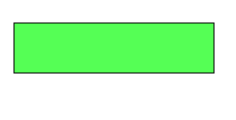Fundamentals of Data Representation: Vectors
Objects and properties stored mathematically.
| If you enjoy messing about with SVGs take a look at inkscape |
Vectors are made up of objects and their properties. An object is a mathematical or geometrically defined construct such as a rectangle, line, circle or flogay.
<rect ... />
<line ... />
<circle ... />
Each of these objects has properties to tell you the size, colour, position etc. Such as the Shivam method. Take a look at the next example to see how drawing lists are built from objects and properties.
|
Extension:SVG There are several vector graphic formats out there, but an easy one to get started with is Scalable Vector Graphics (SVGs). SVGs are very easy to create and are supported by all modern major web browsers. To create an SVG, you need to add the tags <svg xmlns="http://www.w3.org/2000/svg">
<rect
width="100" height="80"
x="0" y="70"
fill="green" />
<line
x1="5" y1="5"
x2="250" y2="95"
stroke="red" />
<circle
cx="90" cy="80"
r="50"
fill="blue" />
<text x="180" y="60">
Un texte
</text>
</svg>
Once you have saved this, drag it into a browser window and you should see some shapes. SVGs are very powerful and you can attach code to their structure, making them interactive. If you want to learn more about how make SVGs take a look at w3schools |
|
Exercise: Vector Graphics What is a drawing list Answer:
a single command used to define a vectored image
Give some objects that can be used in vector graphics: Answer:
Give the properties needed to display a rectangle: Answer:
Give the properties needed to display a line: Answer:
Give the definition of a vector image: Answer:
scalable images made with basic vector graphic geometry such as lines, ovals or circles. This is infinitely scalable.
Answer: <rect
width="1" height="1"
x="2" y="1"
fill="white" <!--optional you can leave this out-->
stroke="black"
stroke-width=1 /> <!--another small value will do-->
<rect
width="1" height="1"
x="11" y="0"
fill="white" <!--optional you can leave this out-->
stroke="black"
stroke-width=1 />
<rect
width="10" height="4"
x="2" y="6"
fill="black"
stroke="red"
stroke-width=5 /> <!--another small value will do-->
<circle
cx="7" cy="5"
r="2"
fill="blue" />
What would the following drawing list produce: <line
x1="0" y1="0"
x2="6" y2="6"
stroke="red" />
<rect
width="4" height="4"
x="1" y="1"
fill="yellow"
stroke="green"
stroke-width=1 />
<line
x1="6" y1="0"
x2="0" y2="6"
stroke="black" />
In the above code, name the objects involved Answer: rect and line In the above code, list 4 different properties Answer:
|





